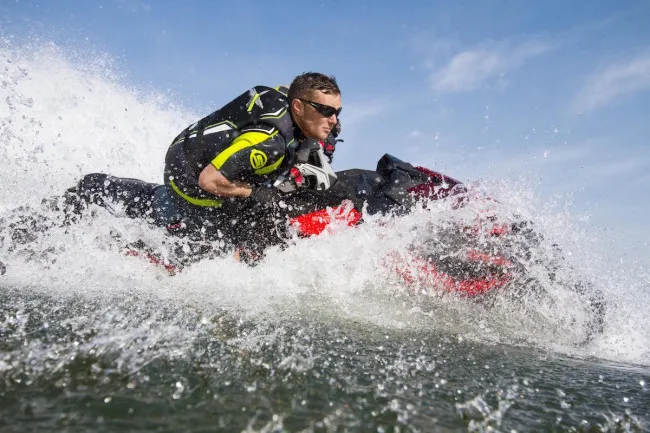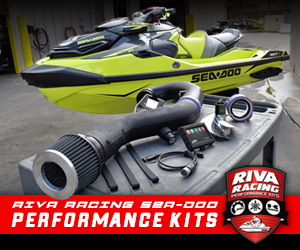Most any person can ride a PWC and have fun on it, but it takes knowledge and skill to ride one correctly. In an article by legendary Jeff Hemmel on PersonalWatercraft.com, he explains how to correctly handle three of the most common riding errors, and we give you the highlights and add some input below:
Porpoising
Porpoising is the up-and-down, leaping and surging effect that can make your ski seem like it’s more of a bucking bronco than a smooth, sleek watercraft. Porpoising tends to occur during hard “start-line” style accelerations on today’s high-powered models, as the sheer power causes the craft to leap out of the water at the hit of the throttle.
Porpoising is a simple issue to correct. The most common mistake that causes porpoising is that the rider’s weight is too far back on the ski, causing too much bow-rise. Most of the time, just moving forward on the ski will make it settle down and stay planted. If you are getting ready to pin the throttle from a dead stop, move your feet farther to the rear of the ski and shift your weight towards the bow. If your watercraft is equipped with trim, set the trim all the way down and begin to trim up once you get the speed up if you are doing a speed run. In a closed course race environment, you may want to leave the trim all the way down the entire race so you have a more aggressive bite through the turns.
Spinning Out
The next handling error is spinning or sliding out. This is a problem that can be quite scary and possibly throw you off, but most of the time, it can be avoided completely by using correct handling techniques. This is an issue that is not near as common as it used to be with older skis, but it still happens from time to time. In the early days of sit-downs, you used to have to actually lean to the outside to avoid breaking loose and sliding uncontrollably. Your instinct tells you to lean into a turn, right? If you are on an older watercraft, you may be in trouble if you follow your instincts. Thankfully, today’s models reward the inside lean, but they can still spin out on occasion.
When you lose control of a PWC, it can be very frightening. With an adjustment to your riding style, though, you can avoid the problem in many cases. Foot placement is an easy solution to this issue. Keep your inside foot(the foot on the inside of the turn) planted firmly towards the front of the footwell, and put your outside foot farther towards the rear of the ski. This will both keep the stern planted in the water as well as give you the leverage needed to power through the turn. Setting the trim all the way down will also help keep more of the hull in the water, which will also keep the ski planted in the water.
Sitting in Rough Water
Even the best rough water hulls on the market can get uncomfortable and bouncy in choppy conditions. Sitting down may seem like the easiest and most comfortable way to ride in this water, when in fact it is not. Standing will allow your legs to act as “shock absorbers” and absorb a lot of the impact. When you are sitting, your spine is absorbing most of the impact, which can really make for an uncomfortable and grueling ride. Standing will also allow you to get a better view of the water ahead.










Just read the Article regarding the “Three Common PWC Handling Errors”. The Author speaks of “Spinning Out” and “Sliding Out” as if this is undesirable to all PWC Pilots. I for one actively attempt to and succeed in doing just that. I find it to the most Fun and Yes, on occasion I’ve been thrown off. The more often I do this the Stronger I’ve become and have improved my riding position while doing so. The worst thing that’s happened so far is that I lost a nice pair of Sunglasses last Fall. I’ve Owned my “2015 Sea Doo GTX 260 is Limited” almost a year now and have Logged over 54 Hours of Aggressive Riding on it. I’m currently 64 and soon to be 65. I’m a Retired Professional Wrench, Audi’s are my Specialty. So far I’ve rebuilt the Supercharger, Jet Pump and installed a Stainless Steel Wear Ring, Diagnosed and replaced a Clogged Fuel Injector caused by Salt Water Entering the Fuel Tank through the “Fuel Cap Vent Valve” during Aggressive Riding (Also Invented a Device to “Catch the Salt Water” and prevent it from making it’s way into the Fuel Tank / Nothing wrong with the Fuel Filler Cap, the Seal or the Vent Valve itself). Replaced the Stock Fuel Pump, Fuel Strainer with Walbro Parts, Wired in a Fuel Pump Relay in the Ground Circuit of the Fuel Pump. I Installed an Automatic Bilge Pump and Switch. Lastly I put together a relatively inexpensive “Jet Fishing Rig” that’s Easy to Install and Remove (relocation of the Fire Extinguisher to up front was required due to the Rear Platform is made inaccessible by the Rig).